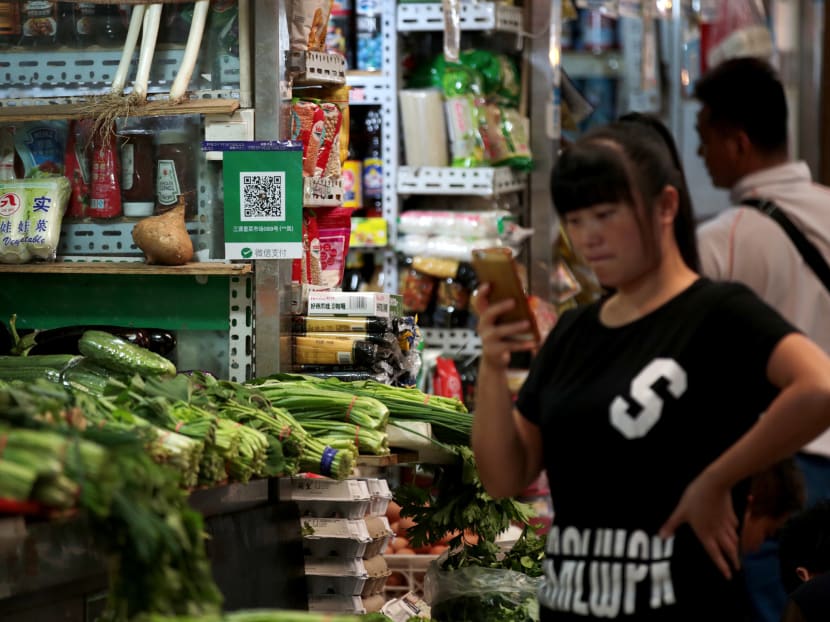The Big Read: How e-payment ended the long reign of cash in Beijing, and the lessons for S'pore
BEIJING — With long rows of vendors selling a smorgasbord of fresh produce, Sanyuanli market in north-eastern Beijing bustles with activity throughout the day, drawing restaurateurs and grocers looking for common foods or exotic products such as porcini mushroom and Italian herbs. Half a kilogram of mint costs about 7 yuan (S$1.43), while 30 yuan gets one a bag of basil.
BEIJING — With long rows of vendors selling a smorgasbord of fresh produce, Sanyuanli market in north-eastern Beijing bustles with activity throughout the day, drawing restaurateurs and grocers looking for common foods or exotic products such as porcini mushroom and Italian herbs. Half a kilogram of mint costs about 7 yuan (S$1.43), while 30 yuan gets one a bag of basil.
Goods packed neatly in crates and styrofoam boxes line the front of each of the 139 stores, with handwritten price charts hanging from the top.
On the surface, the place looks like any other wet market. But on closer look, one would notice the conspicuous absence of baskets containing dollar notes and coins which are commonly seen at other markets.
Instead, pieces of paper displaying QR codes generated by WeChat and Alipay — the biggest players in China’s mobile payments market — are placed haphazardly around the stalls.
With a few swipes of the phone, customers can use their e-wallet to pay for meat, vegetables or fruits: After they launch the application, the customers will scan a stallholder’s QR code, enter the amount to pay, and flash the “payment confirmed” screen to the seller to show that the transaction has gone through.
While cash is still accepted at the market, most patrons here — as well as in other parts of urban China — go about their lives cash-free. QR codes are a ubiquitous sight, be it at hole-in-the-wall drinks kiosks, in taxis, or on meal carts by the road. Buskers, too, are receiving money via these barcodes, while virtual “red packets” — delivered via WeChat’s “Hongbao” function — are now widely used by the Chinese during the Lunar New Year.
New business concepts have also sprung up riding on the cashless wave, such as unmanned karaoke booths tucked away in malls and subway stations, “running booths” and convenience stalls.
During his National Day Rally speech in August, Prime Minister Lee Hsien Loong spoke about how Manpower Minister Lim Swee Say felt like a “suaku” (meaning country bumpkin in Hokkien)) when he was in Shanghai. While queuing to buy roasted chestnuts, Mr Lim observed fellow customers waving their phones when making their purchase. Thinking they were doing so to get a special discount, he told the stall holder that he would be paying the full price - only to realise that the customers were actually scanning the vendor’s QR code with their phones to make payments via their mobile wallets.
Mr Lee related the anecdote as he pointed out how Singapore trails behind other cities, including those in China, when it comes to electronic payments. From buying snacks at roadside stalls to tipping waiters at restaurants, nearly all transactions in China can be paid through e-payment platforms these days, said Mr Lee. Chinese visitors would ask why Singapore was “so backward” when they realised that they had to use cash for transactions here, he added.
.embed-container { position: relative; padding-bottom: 56.25%; height: 0; overflow: hidden; max-width: 100%; } .embed-container iframe, .embed-container object, .embed-container embed { position: absolute; top: 0; left: 0; width: 100%; height: 100%; }E-PAYMENT’S EXPLOSIVE GROWTH
Cash is fast becoming obsolete in the capital city of the world’s most populous country.
The advent of QR codes payments in China has helped small businesses offer another payment option while keeping costs down. Unlike point-of-sale terminals, which cost money to install, QR codes are free and far more space-efficient.
The situation, however, was very different just over a year ago - before a ban on QR code payments put in place since March 2014 by the Chinese authorities, citing the need to protect consumers’ interest, was lifted.
In August last year, the Payment and Clearing Association of China (PCAC) - an industry consortium overseen by the country’s central bank - drew up rules governing such payments. These require users to pay greater attention to encryption of personal data and assets, among other things.
The move dramatically transformed China’s consumption habits. Today, nine out of 10 of the world’s QR code payment users are found in the country, based on an estimate by the People’s Daily newspaper.
According to consulting firm iResearch, Chinese consumers made 38 trillion yuan worth of payments via mobile devices last year. This was 50 times higher than the United States. Mobile payments in the US totalled US$112 billion in 2016, data from Forrester Research showed.
A study by Forrester Research early this year also found that 76 per cent of consumers in the urban areas of China use a mobile wallet or are keen to do so, more than double the proportion (36 per cent) in the United States.
Launched in 2004 as the payment solution for Chinese e-commerce store Taobao, Alipay evolved into a mobile wallet in 2009, and it has captured the lion’s share of the country’s mobile payments market. However, the firm - also the brainchild of Alibaba billionaire founder Jack Ma - is quickly ceding ground to WeChat Pay, an e-wallet function which instant messaging app WeChat introduced in 2013. WeChat is owned by Chinese Internet giant Tencent.
WeChat Pay has about 600 million active users in China, according to a CNBC news report in July. In comparison, Alipay is used by 520 million people worldwide, “most of whom are in China”, its spokesperson Anna Wang told TODAY.
Based on a report by Chinese research firm Analysys, Alipay had a market share of 54.7 per cent in China’s mobile payments market as of the fourth quarter of last year, while Tenpay — which incorporates both WeChat Pay and QQ Wallet — came in second with about 37 per cent. Alipay saw higher transaction amounts, but Tenpay had almost double the number of active users.
During China’s inaugural “cashless week” in August, Alipay and Tenpay went head to head providing lavish incentives for users to go cash-free — discounts, cash rebates and free bus rides, just to name a few.
The Chinese are so comfortable with mobile payments that three in four people are confident of surviving for more than a month with only 100 yuan in cash, according to a recent survey by French market research firm Ipsos, Renmin University of China’s Chongyang Institute for Financial Studies, and Tencent. The survey found that 14 per cent of the respondents do not even carry cash nowadays, while 26 per cent take less than 100 yuan around with them day to day.
The survey asked more than 6,600 people about their payment habits for a range of goods and services, including takeaway food, dining, telecommunications and transport. It ranked Beijing top in a list of 34 Chinese cities for penetration of cashless payments, followed by Shenzhen, Guangzhou and Shanghai.
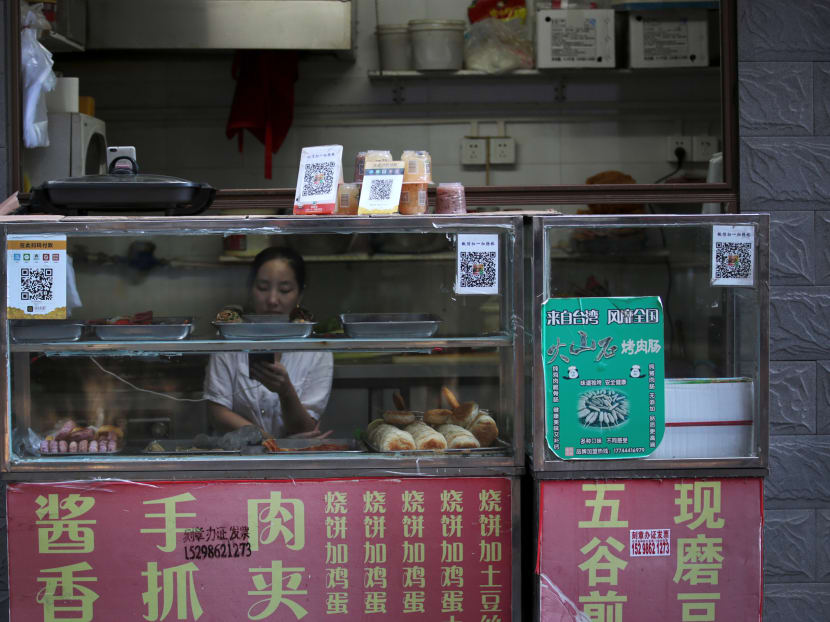
QR codes for cashless payment are displayed at a food stall in Beijing. Photo: Jason Quah/TODAY
CASHLESS PAYMENT ‘MORE SECURE’
IT professional Wang Yufeng goes for weeks without her wallet because “it is no longer necessary”. “I can use my mobile phone from breakfast to dinner, for transport and recreation… I feel more nervous handling cash for fear of being handed counterfeit notes,” said the 27-year-old.
While security and privacy issues are among the chief factors deterring consumers in Singapore from adopting cashless payment modes, the reverse appears to be true in China. Almost all 20 consumers TODAY spoke to along the streets of Beijing said they felt safer using mobile payment methods.
Ms Rie Sawada, a Japanese expatriate who has lived in China for 20 years, noted that Chinese consumers value convenience above everything else. “I have come to realise that for Chinese consumers, convenience trumps other concerns. Nowadays, we can live our lives just around one app, and that is exactly the ‘one-stop shop’ model that Chinese consumers value,” said the food education teacher in her 40s.
App providers and merchants often dangle incentives to entice consumers to pay with their cell phones, she added.
While there has been a recent spate of scams involving QR codes — for example, fraudsters replace legitimate codes with malevolent copies to gain access to consumers’ data — this is unlikely to dampen the mobile payments wave, the consumers interviewed said. “Handling cash and credit cards also give rise to a fair share of security concerns, such as fake notes and lost cards,” Ms Sawada said.
Mobile is king in China, even among many elderly consumers. A 66-year-old cleaner, who gave her name only as Madam Yu, pays with her phone “at least two-thirds of the time” including when she buys groceries and foots the utility bills.
“I am already on WeChat all the time, (to chat) with my friends, read the news, shop online, so learning to use it as an electronic wallet is just a natural progression,” said Mdm Yu.
Mr Zhang Tu Xing, a 62-year-old who sells handmade woodwork at Panjiayuan, Beijing’s largest flea market, said about half of his revenue comes via mobile transactions. “(Mobile payments) have become the trend... We have to get on it, or we may lose a segment of the market,” he said.
Like Sanyuanli wet market, many vendors at Panjiayuan — which operates on weekends — offer mobile payments. Most also sell their wares on Taobao, Alibaba’s e-commerce platform.
Still, the joint survey by Tencent, Ipsos, and Beijing-based Renmin University cited low adoption of mobile payments in the senior demographic as a key challenge. This is due to “long-seated spending habits and perceptions on consumption”, the survey said. Compared with teenagers who carry about 170 yuan in cash with them each day, middle-aged consumers born in the 1960s typically have more than thrice that amount with them.
Mr Jia Dequan, 68, is one such consumer who still prefers cash. “Our eyesight is failing and we worry about keying in the wrong amount. What if I pay 1,000 yuan instead of 100 yuan, due to my own carelessness?” he said.
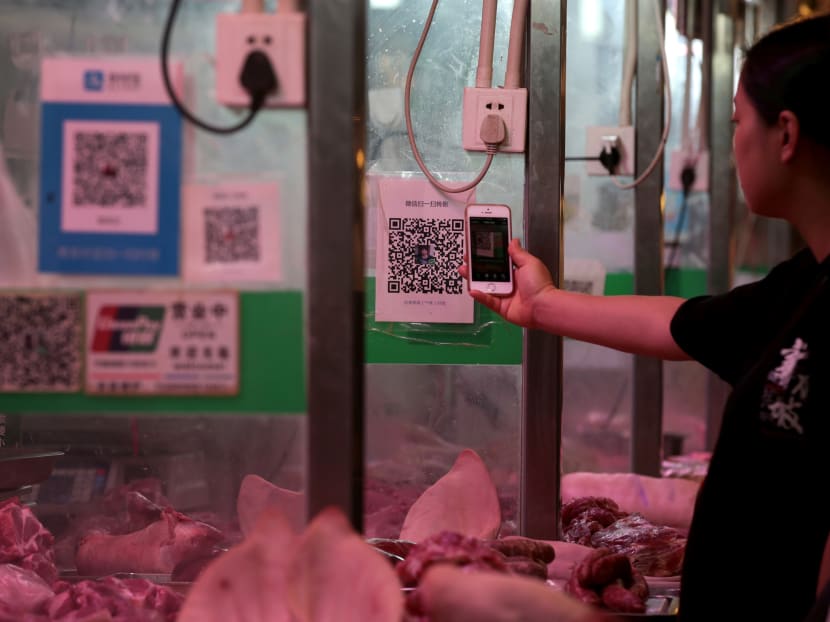
A shopper pays via Wechat Pay at Sanyuanli Market in Beijing. Photo: Jason Quah/TODAY
SPAWNING NEW CONCEPTS
The wave of mobile payments has also fuelled new industries, or made existing ones more efficient, said Mr Bian Yongzu, a research fellow from Renmin University’s Chongyang Institute of Financial Studies.
At least 20,000 unmanned karaoke booths are now operating throughout the country, for instance. According to Chinese state media Xinhua news agency, this vogue industry is expected to hit a market value 3.18 billion yuan this year.
Unstaffed convenience stores are also springing up. One such brand, EatBox, has launched six stores over the last three months in Beijing, Guangzhou, Hangzhou and Shanghai.
TODAY visited its outlet in northwestern Beijing, which uses facial recognition technology and a double-gated system — where only one door can be open at any one time — to ensure security. First-time consumers must register for an account using their WeChat app.
Each EatBox store cost about 100,000 yuan to set up, and it draws a daily revenue of about 3,000 yuan, said the firm’s spokesperson.
The latest concept to hit the market is “running booths” — typically comprising a treadmill, air-conditioner, a mini-television and a fan — which can be found in residential neighbourhoods. Users make appointments to use the booth via a mobile app and pay about 10 yuan via their e-wallets for a 30-minute workout. “As mobile payments become more pervasive, Chinese entrepreneurs are also becoming more creative,” said Mr Bian.
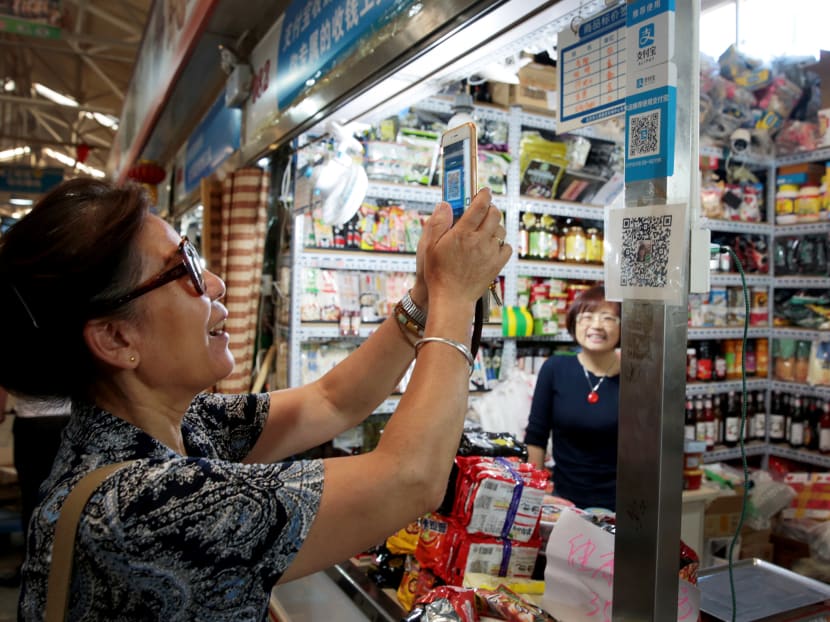
A shopper pays via Alipay at a grocery store at Sanyuanli Market in Beijing. Photo: Jason Quah/TODAY
THE WINNING FORMULA
One vital ingredient in the success of China’s mobile payments market lies in how WeChat and Alipay have built a rich ecosystem of services.
Although it was first launched only in January 2011 as a text and voice messaging app, WeChat has expanded its functions to allow users to call for cabs, buy film tickets, play games, check in for flights, and pay bills.
It even has an online personal investment fund which gives Chinese users an annual interest of about 7 per cent, a better rate of returns than many banks.
Ant Financial, the company behind Alipay, launched Alipay Everywhere last year, an app which works like Uber, Paypal, Tinder and Craiglist rolled into one. With one tap, users can access a map filled with location pins representing people offering various services, from personal training to pet cleaning. Users can also send requests to people nearby for a service.
These apps have been allowed to thrive and monopolise the market because of a sheltered Internet environment in China, said Mr Bian. China operates an extensive censorship system, known by many as the “Great Firewall”, which blocks thousands of websites and popular platforms such as Facebook, Google, Instagram, and YouTube, while coming up with Chinese equivalents of such platforms.
“Life in China now is actually somewhat difficult if you don’t have either WeChat or AliPay, and many stores are even removing cash from the premises after a certain time for security reasons and only accepting mobile payments… Think of it like going to a foreign country, you are going to have to obtain some ‘local currency’ to purchase things and that is what both are doing – building digital worlds almost where only their own currency is accepted tender,” said Mr Michael Yeo, research manager for financial and retail insights at International Data Corporation.
A combination of high smartphone penetration rate and low credit card usage in China - relative to other developed countries - has also facilitated the mobile payments wave, said Mr Yeo.
A report by Ericsson released in June this year showed a 97 per cent smartphone penetration rate in China. In Singapore, the figure stands at over 100 per cent.
“Many Chinese consumers, especially those living in suburban or rural areas, may not have cards or bank accounts, but they probably own a smartphone. There is huge potential for mobile payments to take off in third-tier cities,” said Ms Sawada, who is based in Beijing.
With the country’s growing affluence, consumers are also placing greater priority on service standards, noted Mr Bian. However, existing financial institutions have not been able to catch up with these needs. “As a result, there is a ‘larger runway’ for e-wallet providers to experiment and innovate, compared to other countries where banking and finance services are already very developed, and consumers are used to paying with these methods,” he said.
The sheer size of the Chinese market also fuels the mobile payments industry, he added. “China’s economy has developed very rapidly in the last five to 10 years. Industry players can tap economies of scale,” he said.
Ms Ng Zhi Ying, an analyst with research firm Forrester, who specialises in digital banking, mobile payments and fintech, added: “The surging smartphone user base and booming e-commerce market in China, government policies encouraging mobile payments and innovative players in the market, have all contributed to this trend.”
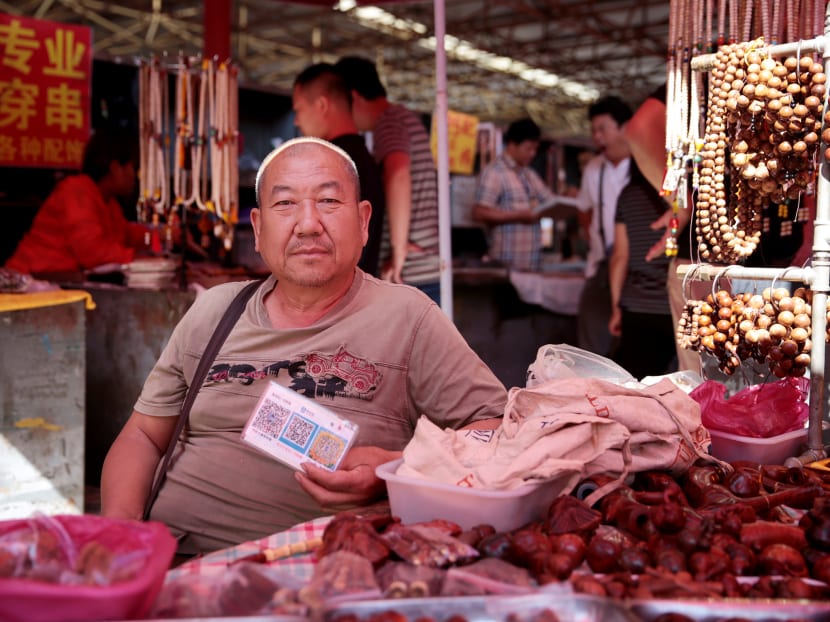
Zhang Tu Xing, 62, sells woodwork at Panjiayuan Flea Market in Beijing. Photo: Jason Quah/TODAY
LESSONS FOR SINGAPORE
In contrast to China, the market in Singapore is heavily fragmented with payment options.
Citing how there are currently four distinct ways to pay with his phone, Mr Yeo said: “Too many brands which all seem to do the same thing will definitely cause some confusion all around... Even the most savvy of consumers are going to get a bit perplexed.”
Ms Ng reiterated that the payments market in Singapore is overcrowded, with little differentiation between various providers. This makes it tough to boost adoption of mobile payments, she added. “Many consumers still don’t see why using mobile payments is a clear improvement over existing systems,” she said.
To take off, new payment methods must offer “obvious and compelling advantages” over the existing options, such as greater simplicity, higher speed, greater security against fraud or better reliability, she added.
Agreeing, Mr Yeo noted that Singapore has established a mature “card culture”. He said: “Singaporeans generally hold more than one card and are quite savvy at reaping the benefits from using specific cards for specific situations.”
Breaking that culture has proven to be a challenge, which is why mobile payment players in Singapore have focused on places where cash is still being used, such as hawker centres, he said. Mobile payments are best targeted at lower-cost transactions, where security risks are also relatively low, he added.
“Consumers are unlikely to buy a new television with a new payment tool. They lose out on a lot of the benefits of cards such as points, promotions, extra warranties as well as the option of spreading payments. Buying lunch at a food court however, is a different matter. If the China experience can be replicated, it is genuinely faster than cash,” said Mr Yeo, who spent four days in Beijing last month living off his WeChat wallet.
The Monetary Authority of Singapore can play a greater role in encouraging cooperation between different stakeholders — including the banks, merchants and e-wallet providers — to develop the overall payments scene “at a more macro level”, Mr Yeo said. “Coordination has been lacking as many put their direct business interests first, rather than entering into partnerships or ecosystem plays with others,” he said.
In August, the Smart Nation & Digital Government Office announced that a common QR code will be rolled out in six months, which allows consumers to pay electronically anywhere just by flashing their smartphones.
Such transactions will be made via PayNow, a digital fund transfer system recently launched to allow customers of seven participating banks to send and receive money instantly using their mobile phone number or NRIC/FIN.
Still, Mr Yeo feels that stakeholders that position themselves solely as a payments tool will find the going tough.
To design a “one-stop shop” model, mobile payment providers in Singapore must build a “rich ecosystem with partners that go beyond just transactions”, said Ms Ng. They must provide value-added services such as allowing customers to accumulate loyalty points and/or redeem vouchers at the point of sale, for example.
Regulators and providers must also do more to protect consumers, said Mr Bian. Alipay in China, for instance, offers a “money-back guarantee” for stolen funds, and virus infections from scanning malicious QR codes.
In response to TODAY’s queries on providing a “one-stop shop” for Singapore consumers, the Republic’s leading payments solutions provider Nets noted that the hardware and software are only parts of the equation.
“What we need (in Singapore) is the behavioural shift towards adoption and usage… As China is a vast country, access to banks and ATMs may not be as convenient as in an urban city like Singapore. Thus, WeChat and Alipay bridges this gap in the market,” said a Nets spokeswoman.
Nets has announced plans to roll out various digital payment modes — including QR codes for mobile payments, new contactless cards and an app storing a digital version of Nets ATM cards — by the middle of next year.
The spokeswoman added: “All our e-payment solutions are built on an open platform so we can accept multiple payment options and wallets… With consumers using their smart devices to track and plan nearly every activity in their lives, it’s only natural that they would also want to use these devices to make payments.”
While some sections of the public remain sceptical about the Government’s push for cashless payments, Mr Yeo said it would bring a “huge host of benefits at the consumer, corporate and governmental levels”.
“This transition is definitely something which should be a goal that Singapore as a nation moves towards,” he added.
Noting the range of possibilities that could be opened up when Singapore becomes a cashless society, Mr Yeo said: “The whole ERP (Electronic Road Pricing) system could be overhauled… Mobile-based systems (could be designed) for corporate claims, and perhaps even car rental firms can consider letting customers use mobile phone payment tools to unlock and pay for shared time in cars.”
He added: “A huge range of potential new industries could spring up. With Singapore’s admirable public safety and security environment, (it) could be a great global test bed for such unmanned systems to be piloted.”

